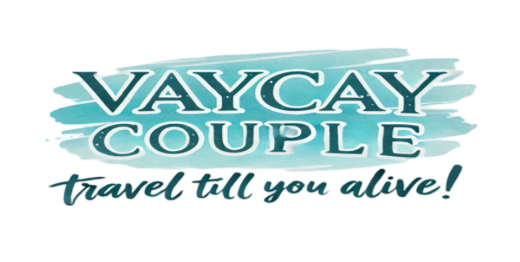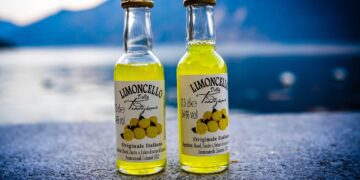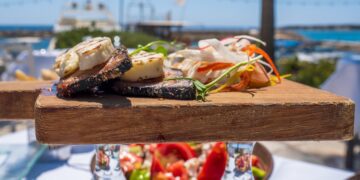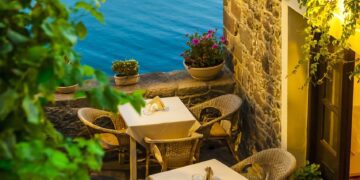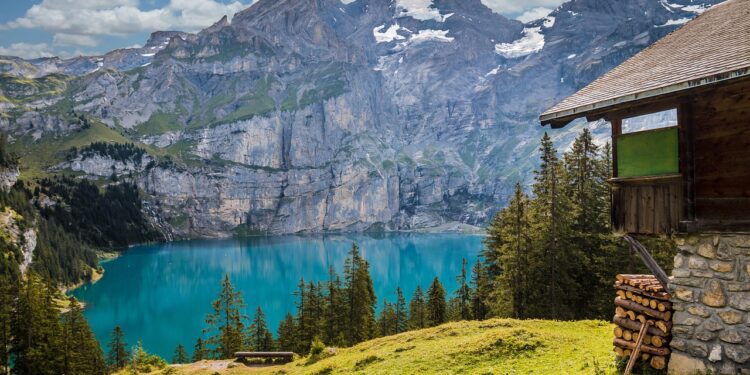Tucked into the karst hinterland of Dalmatia, Blue Lake—Modro Jezero in Croatian—rests in a 220-metre-deep sinkhole on the edge of the little town of Imotski. From spring snow-melt to late-summer drought, the lake’s waterline rises and falls dramatically, colouring the amphitheatre walls in shifting blues and greys that make it one of Croatia’s most photographed inland wonders, and a prime setting for a scenic kayaking itinerary.
1. How Blue Lake Was Born
Geologists believe the basin formed when the roof of a vast subterranean cave collapsed, leaving a sheer-walled chasm nearly 400 m long and 200 m wide. Seasonal springs and underground seepage now fill the bottom, with depth readings fluctuating from dry lakebed in extreme drought to more than 90 m of water after heavy winter snowmelt on nearby Biokovo Mountain.
The lake’s hue comes from dissolved limestone scattering sunlight, a process like that in Plitvice’s turquoise cascades but intensified by the vertical stone bowl that concentrates reflected light.This natural formation makes Blue Lake not only a geological marvel but also a stunning highlight on any inland kayaking itinerary in Croatia.
2. When to Visit—and What to Expect Each Season
| Season | Typical Water Level | Visitor Experience |
| March – May | Rising quickly, often >50 m deep | Mirror-calm turquoise ideal for kayaking* and photography; footpath can be slippery from snowmelt. |
| June – August | 20–40 m, warmest temps | Popular for swimming; SUP rentals operate at the south-east shore. Afternoon heat hikes surface shimmer. |
| September – October | Receding fast; may expose pebble beach | Football and volleyball match sometimes staged on the dry bed if the lake empties—an Imotski tradition. |
| November – February | Variable; may refill after heavy rain | Quietest months; dramatic mist in cold mornings, but occasional closures during freeze–thaw rockfall. |
*Kayaks/SUPs are allowed only when water levels safely cover submerged rocks; check daily notices at the viewpoint kiosk.Planning your kayaking itinerary around these seasonal shifts ensures a safe and rewarding experience.
3. Getting There
- By car: Imotski lies 90 km east of Split; exit the A1 motorway at Zagvozd and follow signs for Imotski (≈1 h). Free parking lines Šetalište Stjepana Radića along the crater rim.
- Public bus: Split ↔ Imotski services run hourly in summer; the lake lookout is a 10-minute downhill walk from the station.
- Guided day tours: Split-Adventure and other operators bundle Blue & Red Lake hikes with winery stops for ~€80 per person.
4. Things to Do
4.1 Rim-to-Beach Hike (1 hr return)
A series of meandering switchbacks—originally mule paths—start beside the café terrace and drop 265 m to the shoreline. Expect loose gravel; sturdy shoes and trekking poles help on the way back up. The lake surface can sit just metres from the trail in spring, or 70 m below it by October.
4.2 Kayaking & Stand-Up Paddleboarding
Local outfitters run pop-up rentals when the water exceeds 30 m depth. Launch from the gentle south-east pebble apron and hug the cliffs clockwise—wind tends to funnel up-valley after 14:00, creating minor chop on the northern side. Average paddling loop: 1.2 km (≈40 min gentle pace). Life jackets are mandatory, and guides carry throw-bags because exit points are few once you leave the beach.
This paddle loop is a perfect base for crafting your own half-day kayaking itinerary, especially in the warmer months when the lake glows with deep hues of blue.
Safety tip: In drought years the lake can vanish entirely—never assume paddling is possible without a same-day check of conditions.
4.3 Cliff-Top Panorama Trail
For a bird’s-eye view, follow the 4.4-mile AllTrails loop that skirts both Blue and neighbouring Red Lake. Way-markers lead across limestone scrub scented with sage and immortelle; from the western ridge, you’ll photograph Red Lake’s 300-metre red-oxide walls dropping into inky water—Europe’s third-largest sinkhole.
4.4 Swim Like a Local
When the water warms above 20 °C (late June onward), locals spread towels on the slim shale terraces. The absence of boats means glass-clear snorkelling: look for tiny crustacean’s endemic to the Imotski karst aquifer.
5. Sample One-Day Kayaking Itinerary
| Time | Activity | Notes |
| 09:00 | Arrive at rim café for espresso & first photos | Morning sun lights the water emerald; parking easiest before tour buses. |
| 09:30 – 10:30 | Hike down to shore | Pause at the midpoint belvedere for Red Lake glimpse. |
| 10:30 – 12:00 | Kayak/SUP circuit | Paddle anticlockwise; cliffs provide shade until 11:00. |
| 12:00 – 13:00 | Picnic & swim | Pack lunch—no vendors lakeside. Shade only on east bank after midday. |
| 13:00 – 14:00 | Return ascent | Steep; allow rest stops. |
| 14:00 – 16:00 | Rim circuit to Red Lake (2 km) | Optional detour; umbrellas of Aleppo pine give relief from heat. |
| 16:00 – 18:00 | Wine & prosciutto tasting in Imotski old town | Try Kujundžuša white at a konoba on the stone square. |
Total walking distance (including Red Lake spur): ~6 km; total paddling 1.2 km.
6. Practical Tips
- Footwear: Flip-flops fine on the beach, but descent path is rocky—wear trail shoes.
- Sun & hydration: Dalmatian hinterland routinely hits 36 °C in July; carry 2 L water and reef-safe sunscreen.
- Leave-no-trace: There are no bins on the lake floor; pack out everything.
- Drone rules: Flights require Croatian Aviation Authority approval inside protected landscapes; fines for unlicensed operation run to €4 000.
- Emergency services: Dial 112; Imotski Mountain Rescue keeps a summer post at the rim kiosk.
7. Beyond Blue Lake
| Nearby Highlight | Distance | Why Go |
| Red Lake (Crveno Jezero) | 1 km walk | Europe’s deepest karst shaft; 500 species of bats and swifts roost in caves. |
| Biokovo Skywalk | 45 min drive | Glass horseshoe balcony 1 224 m above the Adriatic; pair with coastal sunset. |
| Makarska Riviera Beaches | 50 min drive | Cool off in the sea after a hot sinkhole hike. |
| Mostar, Bosnia & Herzegovina | 1 h 20 min | Ottoman bridge jumps & cevapi lunch—passport required. |
8. Sustainability & Local Culture
Blue Lake is designated a geomorphological monument; swimming and non-motorised boating are encouraged, but loud music, graffiti and littering draw on-the-spot penalties. The people of Imotski view the lake as a communal stage—when it dries, a centuries-old football match pits teams Vilenjaci (elves) against Vukodlaci (werewolves) on the cracked clay bed, celebrating resilience and the water’s inevitable return.
Visitors are welcome to watch but not to drive vehicles onto the lake floor. Respect trail closures after heavy rain: rockfalls are frequent when the limestone matrix saturates.
9. Final Word
Whether you glide across its turquoise mirror in spring, plunge into bath-warm water mid-summer, or stand on a bone-dry crater floor in autumn, Blue Lake offers a different face each season—yet always the same sense of awe. Add a hike to Red Lake and an Imotski wine tasting and you’ll have sampled a corner of Croatia that most Adriatic beach-hoppers miss. Pack sturdy shoes, heed the water-level boards, and give yourself at least half a day: Blue Lake is small in surface area but vast in geologic drama.
Want to experience this natural marvel in an entirely new light? Don’t miss our related article: Night-Glow Kayaking Inside Croatia’s Blue Lake Cenote—a magical after-dark adventure where LED-lit kayaks turn this ancient sinkhole into an illuminated ‘dreamscape’.
